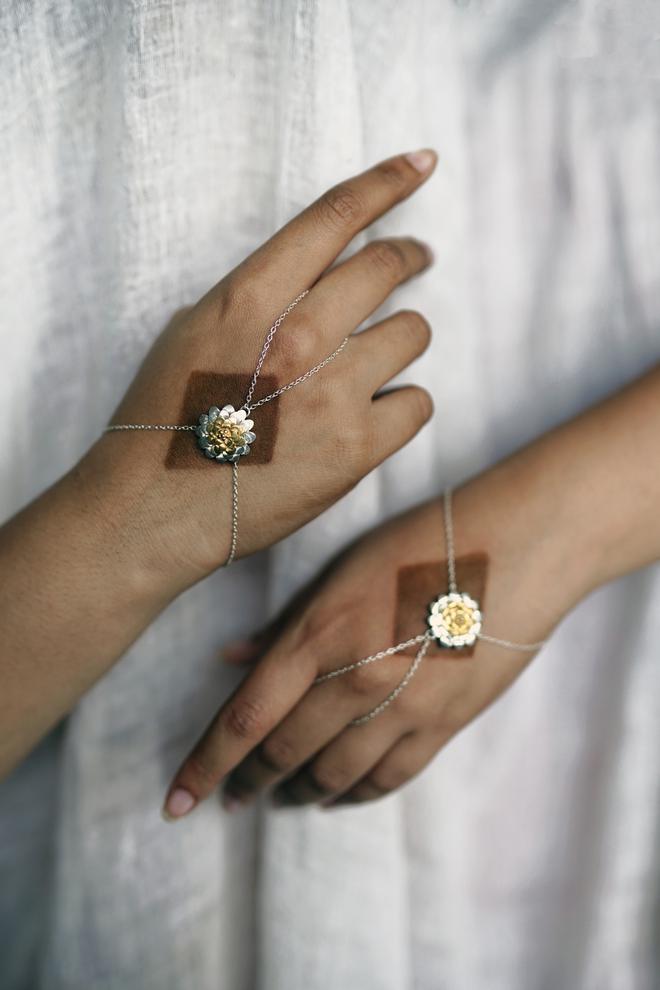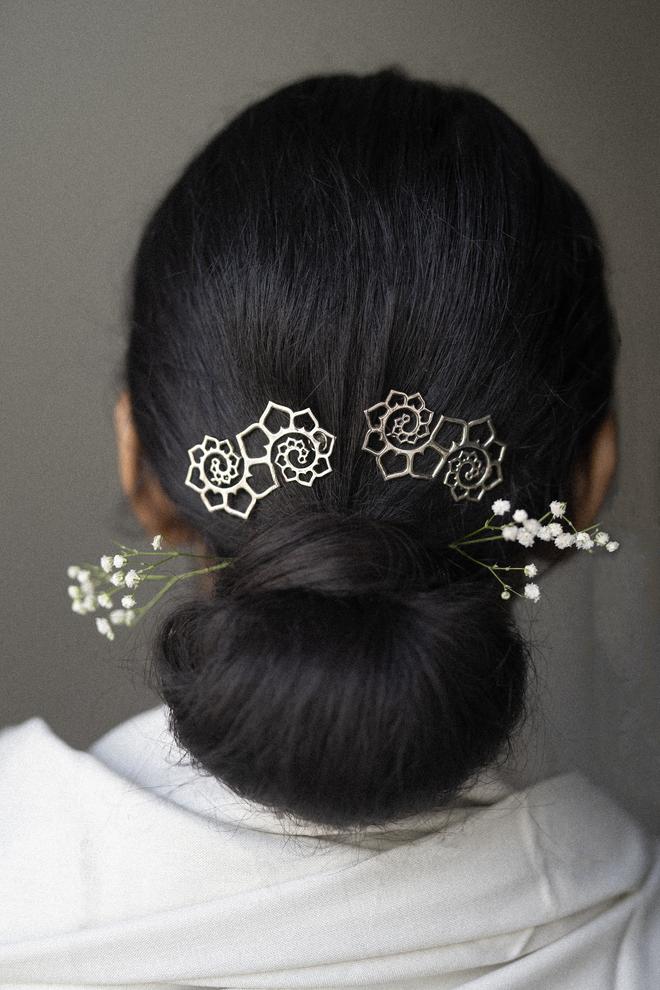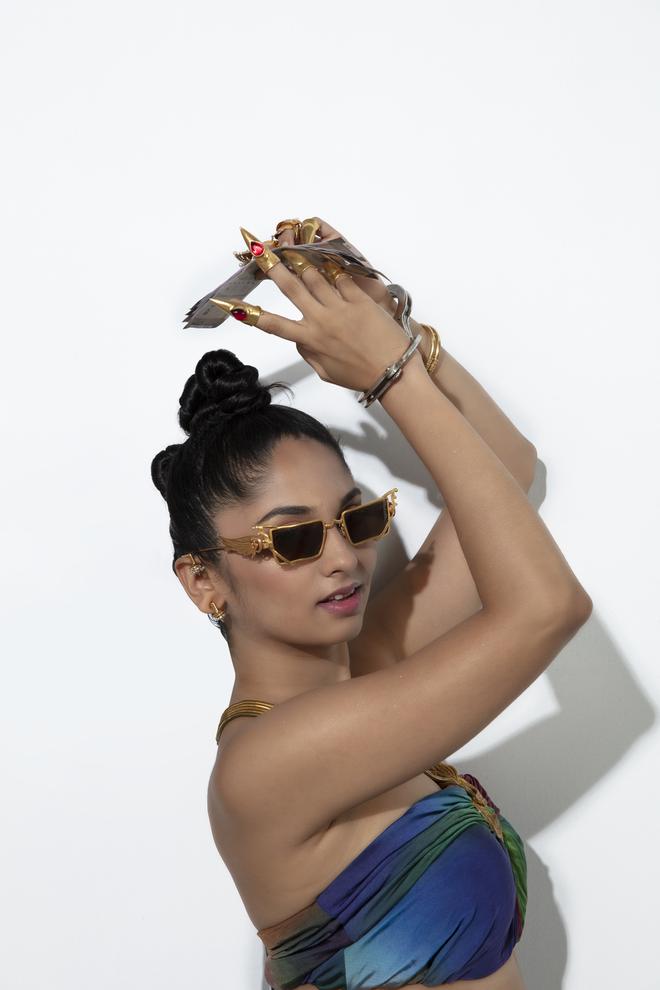The words edgy, unorthodox, and bohemian aptly define the aesthetics of Mumbai-based Bhavya Ramesh’s eponymous silver jewellery label. Rooted in opulent Indianness, her catalogue is unconventional — on it are lip, ear and palm cuffs, ear hangs, joint rings, nail rings and crowns, hair harnesses and clips. And sunglasses too.
“I want to change how jewellery is perceived. Buying jewellery meant ‘let’s go buy gold!’ I want people to enjoy jewellery for its design and functionality!” says Bhavya.

She is echoing the design philosophy of a young wave of indie designers, behind labels such as Quirksmith, Flying Fish Accessories and Oonth Studio, who are expressing themselves in highly stylised ways. At their hands, silver jewellery has acquired a bold and modern identity identity. Desi motifs like paisleys and parrots, leaves and flowers meet kites, safety pins, nibs, bugs, and pinwheels. All made with techniques rooted in traditional Indian jewellery-making.
Silver canvas
“Silver is my canvas,” says Bhavya, who launched her label in 2018, and recently opened a self-designed concept store at Kalaghoda, Mumbai. Her studio is in Jaipur, where visitors can see the karigars working. “Although jewellery is culturally entwined with our lives, its making has always been very ‘underground’. Only the commercial aspect is shown, I want to show how it is done and the craftsmanship that goes into it,” she states.
Making a statement via jewellery was unintentional, confesses the engineer-turned-jewellery designer. Her label is known for bold pieces, like Bhavya Ramesh nail crowns, slipped over the nails [some even cover the fingers]. Their popularity came as a surprise, “I keep my nails very short, so, I thought, why not make jewellery inspired by it — nail crowns. I didn’t think it would become popular. The true sign of success, in terms of design and product, is the following it gets — how it is liked,” she says.
Take, for instance, Bhavya Ramesh silver sunglasses. “I wanted to show it was doable, wearable and saleable. It got its following!” The glasses also ended up being featured in a movie, worn by Rashmika Mandanna.

Jewellery is a means of self-expression; a statement of self — of the designer and the wearer. Like Bengaluru-based Quirksmith Jewellery’s Akshar collection where the aham brahmasmi ear cuff, vidrohi anklet and nakadapi khandit necklace “convey something for the wearer, like a tattoo.
“The inspiration is not visual, each piece is well-thought out. This is not just a piece of jewellery,” says Divya Batra, who co-founded Quirksmith in 2016 with her sister Pragya. Their design philosophy is “wear your emotions, alongside the piece of jewellery being a conversation starter”. The jewellery-design graduate from NIFT says, she wants to “design pieces that speak to and about the wearer.”
That said, silver jewellery is as much about the designer as the wearer. According to Neetika Bose, founder of Flying Fish Accessories, the genesis of the design process lies in the question — ‘what do I want to wear?’ The designs then grow organically from there.
Neetika works with silversmiths in Jaipur, Kolkata and Delhi and her brand finds whimsy in ‘everyday kind of ideas’ like the charkhi (pinwheel) brooch, with a pinwheel that moves or the ‘There’s a Bug on Your Nose’ nosepin.
Stating that “silver jewellery is as long-lasting as gold,” Neetika says that there has been a “noticeable maturing of attitude towards silver, which is comparatively recent.” She says clients are now accepting of pieces that look different, and fantastical, in terms of design.
Another contributing factor is that millennials spend on silver jewellery. “They want, and spend on, pieces that can be styled with a blazer or a suit to work. Our hand harness, hathphool, is an example,” says Meerut-based Ivanka Agarwal founder of Oonth Studio. The brand’s palm cuff is a minimalist piece with a sinuous wire of silver that loosely hugs the palm or the harness, a cloth and a silver buckle combination, which can be worn over a shirt. “There is a leather version too. A lot of what I do are experiments, what I would like for myself. It so happens that other women like and want them as well,” says Ivanka.
Changing attitude
The galloping prices of gold could be a factor in the older generation being open to silver, which was earlier perceived as ‘costume jewellery’. However, gold is still seen as an investment and heirloom that can be handed down. A kilogram of silver now costs around ₹70,000 while 10 grams of gold costs in the region of ₹60,000 — putting the figures here for perspective. The prices of silver jewellery start at ₹500 and can go up to ₹30,000 or more. There are gold-plated options as well.
With jewellery being seen as androgynous nowadays: men can wear them as well. In fact Bhavya Ramesh ad campaigns use male models. “I don’t assign gender to jewellery, if men want to sport them they can. I have been asked for ‘masculine’ pieces, men have told me that they would like to buy something. They want simple, neat and plain pieces,” Bhavya explains. Quirksmith, on the other hand, has thumb rings, hoops, brooches, pendants, watch charms and bookmarks designed for men.

Quirksmith has a sustainability angle to its jewellery as well. The label, which works with five clusters of women silversmiths in Kolkata, advocates buying less and wearing more. Divya posts how-to videos on the Quirksmith’s Instagram handle showing the many ways of wearing earrings or what to do if one is lost.
She says, if you lose an anklet of a pair, you use the remaining one as a necklace. The pendant on the silver rakhi transforms into a watch charm [to be worn with watches]. It is all part of what Divya calls ‘problem-solving’. If a piece is damaged, it will be repaired, “We will do it happily, with an open heart,” says Divya. The goal, she underlines, is to encourage people to buy less, and use more.
The business is not all sunshine and rainbows. Neetika says despite the upswing in the trend, there are those who question the prices. “While 95% understand the value of a handcrafted piece of jewellery, there are those who question the prices. ‘This is just a four-gram piece, why this price?’ There is value to these, they are handcrafted…,” Neetika says.
It is not quite, as a line from the jhumka song in Rocky and Rani ki Prem Kahaani goes, ‘what jhumka?’ yet, but it looks like we are getting there!







